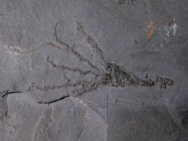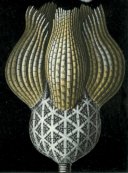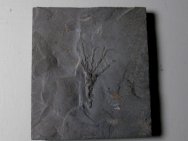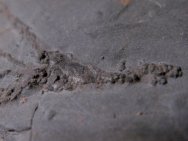|
Phylum Echinodermata, Subphylum Blastozoa (extinct), Class Eocrinoidea,
Order Gogiida, Family Eocrinidae
Geological
Time:
Middle
Cambrian
Size
(25.4 mm = 1 inch) Gogia fossil is 38 mm long on 72 by 65 mm matrix
Fossil Site:
Wheeler Formation, Millard County, Utah
Code: SRC89
Price: Sold
|
 This
is an excellent example of the Cambrian Eocrinoid Gogia spiralis.
Gogia
was among the This
is an excellent example of the Cambrian Eocrinoid Gogia spiralis.
Gogia
was among the  earliest
groups of echinoderms, existing from the early to middle Cambrian.
For this reason they are often called "dawn crinoids".
They had a vase-shaped body (calyx), covered by plates that were
symmetrical and have a bifurcated brachiole, a slender arm-like
structure for food-gathering that closely resembled those in cystoids.
Gogia and other eocrinoids were not closely related
to the true crinoids, and were actually more closely
related to the extinct blastoids that perished in the Permian-Triassic
extinction event when some 96% of marine species perished. earliest
groups of echinoderms, existing from the early to middle Cambrian.
For this reason they are often called "dawn crinoids".
They had a vase-shaped body (calyx), covered by plates that were
symmetrical and have a bifurcated brachiole, a slender arm-like
structure for food-gathering that closely resembled those in cystoids.
Gogia and other eocrinoids were not closely related
to the true crinoids, and were actually more closely
related to the extinct blastoids that perished in the Permian-Triassic
extinction event when some 96% of marine species perished.
|
|



